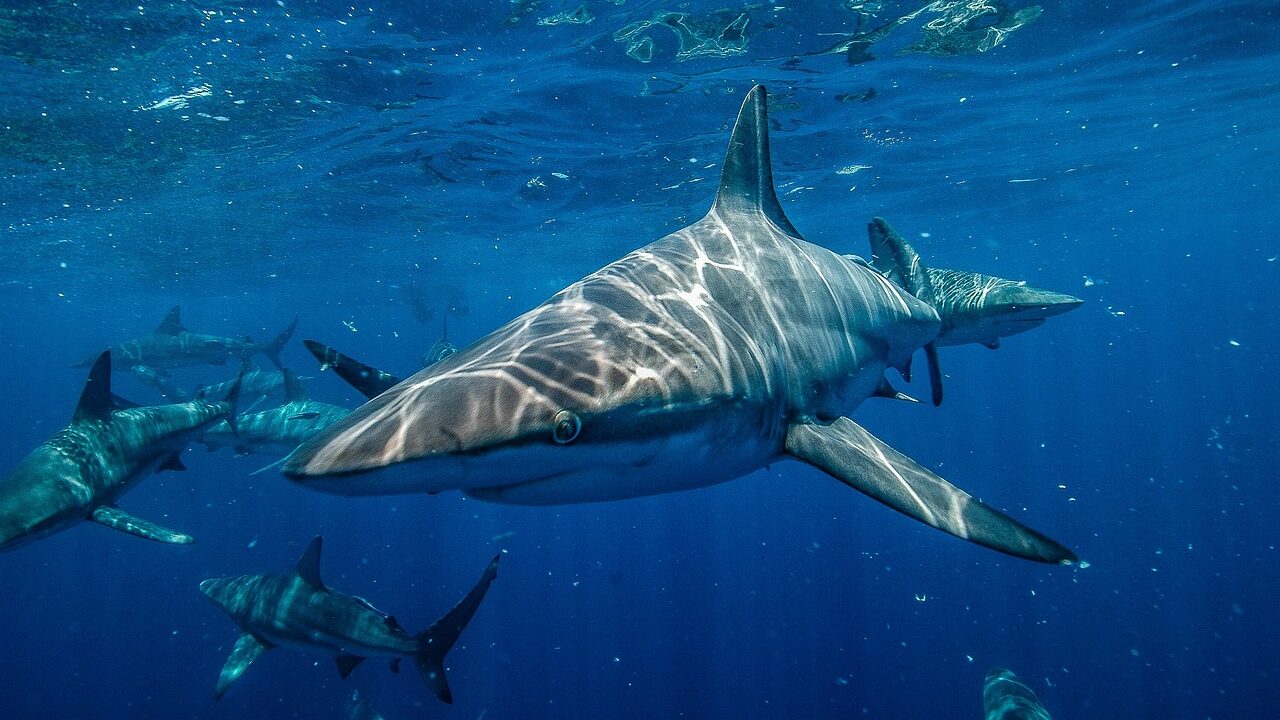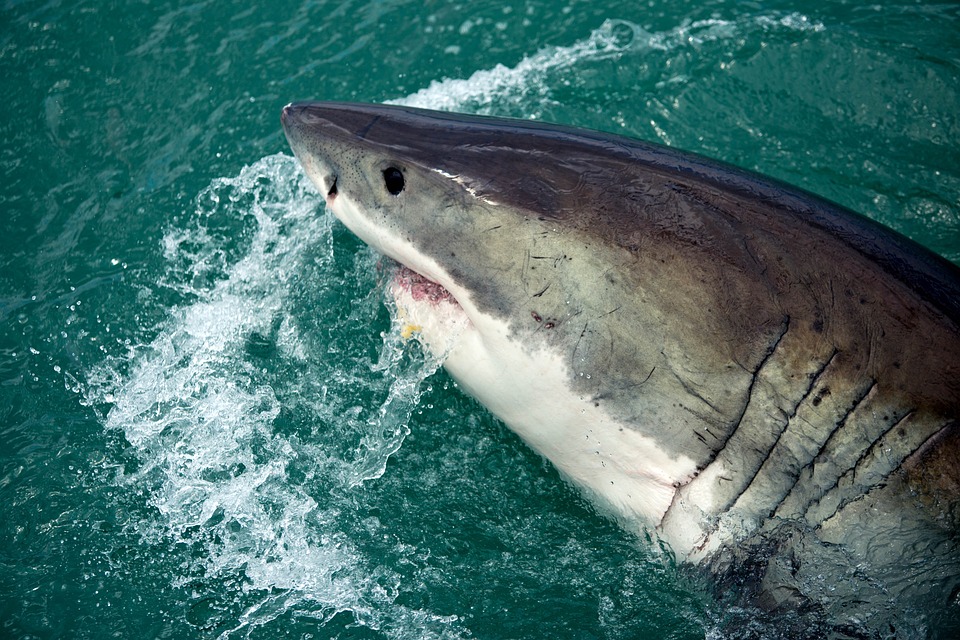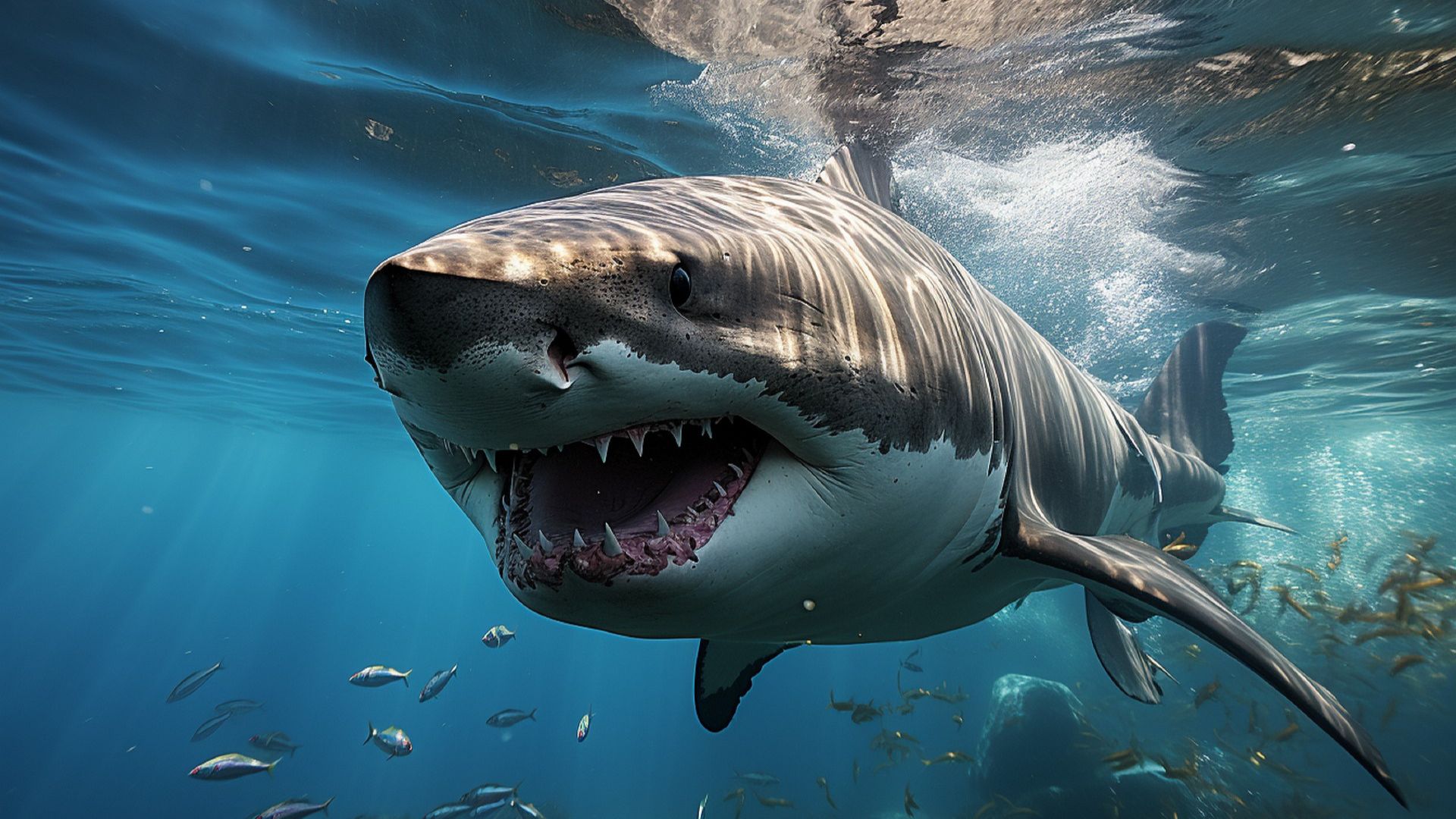The International Shark Attack File (ISAF) from the Florida Museum of Natural History looked into 120 reported shark-human interactions across the globe in 2023. Among them, there were 69 unprovoked shark attacks, exceeding the five-year average of 63 attacks per year. However, experts stress that this doesn’t necessarily mean shark attacks are on the rise.
Many people have a firm view on sharks; however, the following shark attack numbers will highlight the truth behind these majestic creatures.
Sharks are intensely beautiful creatures. I have long been fascinated by them, from the monstrous creatures of Jaws and the Meg to the real creatures that gracefully dominate our oceans. Sharks are all around tremendous animals.
Peter Benchley, the man behind Jaws, wrote his book about the killer shark but spent the rest of his days undoing the devastating image he created. Sharks have a fearsome reputation, and while they are undoubtedly apex predators, they are much more than that.
Key Facts You Need to Know
- In 2023, There Were 36 Unprovoked Shark Bites on Humans in the US
- 16 Cases in Florida Represent 44% of the US Total Shark Attacks in 2023
- Stats Show There Were 69 Unprovoked Bites on Humans and 22 Provoked Attacks in 2023
- The Number of Highest Unprovoked Shark Attacks in the US
- The Second Place with the Highest Number of Shark Attacks after the US Is Australia
- One of the Most Dangerous Shark Beaches in the World Is Gansbaai
- The Likelihood of Fatal Shark Attacks Is 1 in 4,332,817
- Shark Attacks Are Highest in the Month of September
- Most of the Fatalities in 2023 Were Due to White Shark Bites
- The Biggest Shark in the World Is the Whale Shark
Why Do Sharks Attack People?

The main reason sharks attack people is because of curiosity. While it doesn’t make a very good catchphrase, curiosity is what draws sharks to humans. When humans enter the water and start swimming, paddling, or splashing around, they draw a shark’s attention.
There is no objective evidence to suggest that sharks actively hunt humans in the water. More attacks usually happen because more people are in the water, not because sharks are getting more dangerous. It’s all about the numbers. The more we swim in their home, the more we might run into them.
Below are some statistics discussing why sharks attack people.
How Many Shark Attacks Happen Each Year?

On average, there are about 63 unprovoked shark attacks each year, with 5 to 6 of these attacks resulting in death. In 2023, there was a slight increase to 69 attacks, but this number still fits the average trend over the past five years.
In 2022, attacks dropped to 57, marking a 10-year low. The ISAF’s annual report mainly looks at unprovoked shark attacks, where sharks bite without human provocation, like approaching them or swimming near the bait. These incidents help us understand shark behavior better. So, although attacks by sharks do happen, the overall risk remains quite low.
Shark Attacks in the US

In 2023, There Were 36 Unprovoked Shark Bites on Humans in the US (ISAF)
Shark attack data confirms that the US is the geographical home for shark bites. In line with ongoing trends, the United States had the highest number of unprovoked shark bites in 2023, with 36 confirmed incidents.
This figure is a slight decrease from the 41 cases in 2022, accounting for 52% of the global total number according to a report of all known attacks by sharks compiled by Florida’s Museum of Natural History.
In 2022, there were 108 shark interactions reported worldwide. Of these, the ISAF recorded 73 unprovoked shark bites or attacks in the United States.
There Were Also Two Confirmed Deaths in the U.S. (ISAF)
Last year, the number of fatal unprovoked shark attacks increased to ten, doubling from five the previous year. In the US, two of these attacks resulted in deaths, with one occurring in California and another in Hawaii.
In 2023, Hawaii Recorded Eight Shark Attacks, While California Recorded Two Attacks (ISAF)
In 2023, Hawaii had eight shark bites, with one being deadly. This is a bit more than usual, but the number of bites in Hawaii changes a lot each year.
California had two shark bites, one fatal. New York saw four bites, North Carolina three, South Carolina two, and New Jersey one.
A Fatal Shark Attack Occurred in Massachusetts for the First Time Since 1936 (CNN)
As reported by CNN, 2018 saw the first fatal shark bite recorded in Massachusetts in 82 years. Before the attack on the 15th of September 2018, the most recent fatal attack was recorded in 1936.
Many believe the surging population of seals on the coast has beckoned more Great White shark populations to the area.
Shark Attacks Florida
16 Cases in Florida Represent 44% of the US Total Shark Attacks in 2023 (ISAF)
Florida continued to lead the world in shark bites in 2023, with its 16 cases making up 44% of the U.S. total and 23% of the global unprovoked bites. This number is below Florida’s recent five-year average of 19 incidents.
23% of the Unprovoked Shark Bites Worldwide Occur in Florida (ISAF)
The same source data can be used to determine that Florida is responsible not only for 44% of unprovoked shark bites across the US but also for almost a quarter (23%) of unprovoked bites worldwide.
Volusia County in Florida Had the Highest Number of Shark Bites (8), Representing 50% of the State’s Total (ISAF)
The same ISAF study examined the total number of unprovoked shark bites in Florida to determine that Volusia County is the hotbed of Floridian shark activity, accounting for 50% of all Florida’s attacks. This represents a slight increase from 44% in 2022, indicating a modest uptick in shark activity in the area.
In Florida, Volusia County recorded the highest number of shark bites at 8, accounting for half of the state’s total. This matches the area’s five-year average of 9 incidents.
Of the Eight Remaining Bites, Two Were in Brevard County, Two in St. Lucie County, and One Each Occurred in Miami-Dade, Palm Beach, Escambia, and Pinellas Counties (ISAF)
Of the remaining bites, Brevard and St. Lucie counties each had two, while Miami-Dade, Palm Beach, Escambia, and Pinellas counties each reported one.
Most Shark Attacks Worldwide Statistics

Stats Show There Were 69 Unprovoked Bites on Humans and 22 Provoked Attacks in 2023 (ISAF)
In 2023, there were 69 shark attacks worldwide, similar to the average of 63 a year from 2018 to 2022. However, there were 14 deaths from attacks this year, with 10 considered unprovoked, which is higher than the usual annual average of 6 unprovoked deaths.
It’s normal for the number of attacks and deaths to vary each year. Even though there were more deaths in 2023, similar spikes have happened before, like in 2011. The recent increase in deaths, especially from white sharks, might be due to more sharks gathering near popular beaches, especially in Australia, where many surfers go.
The Number of Highest Unprovoked Shark Attacks Are in the US (ISAF)
According to data from the ISAF, the US has the highest rate of unprovoked bites in the world, and within that, Florida accounts for 44% of all US-based shark bites.
The USA reported 1640 attacks since 1580, which is almost double that of Australia, which is the country with the second most attacks.
The Second Place with the Highest Number of Shark Attacks after the US Is Australia (ISAF)
An attack map published by ISAF confirmed that after the US, Australia is the second most active country for shark attacks.
However, while it may rank second for activity, Australia is the number one country for fatal attacks.
Australia accounted for 22% of Attacks, Resulting in 40% of Fatalities. (ISAF)
Australia recorded 15 unprovoked shark incidents in total, matching the region’s five-year average. Australia experienced a higher number of shark bite fatalities, making up 22% of all global attacks and resulting in four deaths, which is 40% of the total fatalities.
Of these, seven happened in Western Australia, with one fatal incident involving a bull shark, and five occurred in South Australia, where three were fatal and involved white sharks. Additionally, there was one shark bite each in Queensland, New South Wales, and Tasmania over the year.
From 1931 to 2022, Brazil Had 111 Shark Attacks (ISAF)
In 2023, Brazil reported three bites, none of which were fatal. Research collected in the International Shark Attack File confirms that between 1931 and 2021, Brazil saw 111 total attacks by sharks.
Out of those 111 incidents, 65 occurred off the coast of the state of Pernambuco.
One of the Most Dangerous Shark Beaches in the World Is Gansbaai (American Oceans)
Sharks are found in seas and oceans the world over, and despite the record number of attacks and incidents in the US and Australia, one of the most heavily shark attack hotspots of the world is off the South African coast.
Getaway reports that Gansbaai sees anywhere between 5 to 10 shark attacks per year. Sharks have become one of the key tourist attractions in the area.
In 2019, 2 Fatal Shark Attacks Occurred in the Bahama Islands and Reunion Island (Florida Museum of Natural History)
According to data gathered and published by the ISAF at the Florida Museum, 2019 saw a drop in the total number of shark-related incidents. Only 64 unprovoked bites were reported.
However, two particular bites proved fatal – one in the Bahamas and one on Reunion Island. Interestingly, this also represented a 50% decrease compared to the average.
Shark Attack Statistics

The Likelihood of Fatal Shark Attacks Is 1 in 4,332,817 (Florida Museum)
According to the Florida Museum of Natural History, it was revealed that the odds of dying as a result of a shark attack in the USA is 1 in 4,332,817.
This means that you are more likely to die from an attack from wasps, dogs, or snakes than you are from sharks.
The Rate of People Getting Drowned Is Higher than Getting Bitten by a Shark (Florida Museum)
As per a study by the International Shark Attack File, you are more likely to die by drowning than be bitten by a shark. To further quantify those statistics, you are 3,820 times more likely to drown than die from a shark bite.
The chances of drowning are 1 in 1,134 compared to the 1 in 4,332,817 odds of being bitten by a shark.
Shockingly, Deaths Due to Selfies Are Higher than Being Eaten by Sharks (NY Post)
In an article published in the NY Post, more people have died while taking a selfie in recent years than from attacks by sharks.
Between 2011 and 2017, 259 people died while taking a selfie, as opposed to just 50 shark-related deaths in the same time span.
Board Sports and Surfing Are Involved in 42% of Shark Attacks (ISAF)
In a report published by the ISAF, more than half of all reported shark attacks are a direct result of board sports and surfing. The article specifies that swimmers and waders were involved in 39% of the incidents, while snorkelers and free divers accounted for 13%.
Shark Attacks Are Highest in the Month of September (ISAF)
The ISAF is the only known repository for shark altercation statistics. According to their research, the most active month for shark attacks is September. The data relates to attacks in Florida, which is the most active location in the US for shark bites.
Stats Show Several Factors, Including Climate Change, Are Involved in Shark Attacks (BBC)
A BBC report concludes that a rise in the rate of attacks on humans is related to a number of different factors. As the number of unprovoked shark bites worldwide seems to be on the increase, the reasoning behind it is linked to multiple environmental factors.
Climate change is altering water temperatures worldwide, and as a result, shark’s natural habitat and shark attack migration paths are growing. In addition, conservation efforts are seeing seal colonies and other shark prey populations increase, thus luring even more sharks into coastal waters.
There Are Three Types of Unprovoked Shark Attacks (ISAF)

The ISAF curator, George Burgess, documented that there are three different types of attacks by sharks. These were examined in detail by Wildlife Online.
The three types of shark bites are:
- Hit and Run attack: Often unseen, a shark will attack quickly, take a bite and disappear. A hit-and-run attack is the most common shark interaction.
- Bump and bite attack: The bump and bite is most commonly related to feeding. These are most often severe or fatal attacks. Sharks bump their prey before circling back for multiple attacks.
- Sneak attack: Sneak attacks are a combination of the above. They occur without warning and often result in multiple bites.
Shark Attack Statistics by Species

There Are Almost 500 Known Shark Species, among Which Only 30 Are Involved in Attacks on Humans (Florida Museum)
Between sharks and rays, there are approximately 1,000 different species on the planet, yet according to statistics from the Florida Museum of Natural History, only 30 have ever been involved in unprovoked bites on humans.
This means that only between 3 and 5 % of shark species have ever attacked a human.
Since 1580, 949 Unprovoked Shark Attacks Have Been Documented Globally. (ISAF)
Since 1580, there have been 949 unprovoked attacks globally. Great white sharks were involved in 37% (351 attacks) of these, with 59 being fatal.
Most of the Fatalities in 2023 Were Due to White Shark Bites (ISAF)
In 2023, most fatalities were caused by white shark bites, with three in Australia and one in California. According to the Florida Museum, the Great White is the most dangerous shark to humans.
Most unprovoked attacks by sharks are test bites, where a shark senses humans (mistakenly) as their usual prey and often leaves after one bite. However, because of their size, many species, like white and tiger sharks, can cause fatal injuries with just a single bite or two bites.
Since 1580, 351 Unprovoked Bites Have Been Attributed to White Sharks. (ISAF)
The Great White has been responsible for a record 59 fatal human bites over the centuries. They have also been involved in a staggering 351 unprovoked shark bites, which accounted for 326 attacks and 52 fatalities earlier.
The Bite Force of a Great White Shark Is More than 4,000 PSI (American Oceans)
According to American Oceans, the great white shark has a bite force of 4,000 pounds per square inch (psi).
To add some perspective, the force of a Great White shark bite is approximately 10 times more than a lion!
The Second Most Dangerous Sharks in the World Are Tiger Sharks (ISAF)
While Great White sharks are regarded as the most aggressive ocean predator, they are followed close behind by the Tiger shark.
Tiger sharks are, according to the ISAF, unaggressive and often docile sharks; however, they are still second in the number of human attacks and shark-related fatalities. Tiger sharks have been involved in 103 unprovoked attacks and caused 39 fatalities.
Stats Show the Incidence of Bull Sharks Attacks Is Highest in Shallow Waters (NWF)
Bull sharks are clever creatures that can move from freshwater to saltwater without issue. As a result, they often move into shallow rivers and bodies of water. This brings the bull shark into close contact with humans.
According to NWF, Bull sharks are also naturally inquisitive and use their mouth as a way of exploring and investigating.
Tiger sharks caused 142 unprovoked shark bites, and bull sharks caused 119 during that period since 1580. (ISAF)
ISAF warns that shark unprovoked attack figures might not be precise due to misidentification. Yet, bull sharks, tiger sharks, and great white sharks, known as “The Big Three,” cause about 65% of attacks worldwide. They’re known for serious injuries and often roam near human areas.
Hammered Shark Attacks on Humans Didn’t Cause Any Casualties (Newsweek)
According to an article in Newsweek, Hammerhead sharks have not been the cause of human fatality for over 120 years.
While the Hammerhead is the most recognizable of all shark species, it is highly placid. There have been just 16 incidents involving people, and none of them have been fatal.
The Biggest Shark in the World Is the Whale Shark (Oceana)
The largest shark in the world is the Whale shark. However, as confirmed by Oceana, despite being the largest living fish, the whale shark is utterly harmless. One of three filter-feeding sharks, Whale sharks pose no threat to humans.
Interestingly, the spotted pattern on a Whale shark’s hide is as unique as a human fingerprint.
How Many Sharks Are Killed by Humans Statistics

Globally, There Are More Than 100 Million Shark Deaths (American Oceans)
While sharks kill around 10 people a year, humans are responsible for killing tens of millions of sharks. According to American Oceans, approximately 6.4 to 7.9% of all shark species are killed each year.
To further quantify that, there are approximately 11,000 sharks killed every hour!
73 To 100 Million Sharks Are Killed For Their Fins (Shark Research Institue)
Shark populations worldwide are rapidly declining, largely due to the high demand for their fins, which are used in a status-symbol soup served at weddings and banquets across Asia. Each year, an estimated 73 to 100 million sharks are killed globally solely for their fins. Some shark populations have plummeted by up to 99%, leaving them nearly extinct in their ecosystems.
In shark finning, sharks are caught, their finds are removed, and the shark is returned to the ocean, alive, and left behind to drown. It is the major cause of shark mortality.
Overfishing Has Dropped the Level of Sharks by 71% (Marine Megafauna Foundation)
Over the past 50 years, the global population of oceanic sharks and rays has dropped by nearly 71%, mainly because of overfishing. This decline aligns with a doubling of fishing efforts and a threefold increase in catches, resulting in an 18-fold rise in relative fishing pressure. The main reason behind this is the continued expansion of commercial fishing zones.

Overfishing of the oceans has seen a vast reduction in the amount of food available for most sharks. The follow-up from this is that more sharks are dying, which, coupled with the relatively slow reproduction rate, means there are fewer sharks swimming in our oceans.
Ten Critically Endangered Gray Nurse Sharks Were Killed in the Nets in New South Wales from 2017-2018 (The Guardian)
As part of a shark deterrent system, nets were used around beaches in New South Wales with a focus on catching rogue tiger or white sharks, which pose the greatest risk to humans.
However, according to research and an article in the Guardian, between 2017 and 2018, the nets caught and killed 6 critically endangered gray nurse sharks.
Between 1950 to 2008, 577 Great White Sharks And 353 Tiger Sharks Were Killed in Nets (Taronga)
Shark attack mitigation nets in New South Wales, Australia, have caused the deaths of almost 1000 sharks between 1950 and 2008. These deaths were not the goal of the nets but an unfortunate consequence of them.
As discussed on Taronga.org, there are better and more humane ways to limit interactions between humans and sharks, especially when you consider that there were over 15,000 other marine mammals also killed in the same nets during that time.
FAQs
How many shark attacks per year?
In 2023, there were 69 unprovoked attacks, while 2022 saw 57 worldwide. This marks a change from the 10-year average of 63 attacks per year, as noted by the University of Florida.
How many people are killed by sharks each year?
On average, less than 10 people are killed by sharks worldwide each year.
How many shark attacks in 2022?
During 2022, there were a total of 108 shark interactions worldwide, and ISAF documented 73 unprovoked shark bites or attacks in the United States.
What state has the most shark attacks?
Florida has the highest number of attacks.
What are the chances of getting attacked by a shark?
As per ISAF, the odds of being killed or even attacked by a shark is one in 4.3 million around the world. You are 1500 times more likely to be attacked by a bear than a shark.
Conclusion
Sharks are an often misunderstood species that are viewed as nothing more than cold-blooded killers. Yes, sharks are effective eating machines, but they are so much more than that. As per ISAF, the risk of death from a shark attack is one in 4.3 million around the world.
The above shark statistics also show that the risk they pose is nothing compared to the risk we pose to them. As a long-time lover of sharks, I am all in favor of helping educate people to better understand these amazing creatures.
Have you ever encountered a shark in the wild? How did it happen? What did you take away from your experience? Let us know in the comments; we’d love to hear from you!


